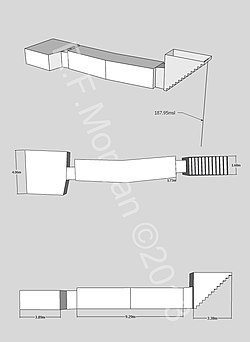KV37
| KV37 | |
|---|---|
| Burial site of Unknown | |
 Schematic of KV37 | |
| Coordinates | 25°44′18.6″N32°36′02.5″E/ 25.738500°N 32.600694°E |
| Location | East Valley of the Kings |
| Discovered | 1899 |
| Excavated by | Victor Loret(1899) University of Basel(2016–17) |
←Previous KV36 Next→ KV38 | |
Tomb KV37is anancient Egyptian tombin theValley of the KingsnearLuxor,Egypt. Bone fragments and white-washed storage jars indicate that the tomb was used for a burial, probably in theEighteenth Dynasty.However, its original occupants are unknown.[1]
Location, discovery and excavation
[edit]KV37 is located in a side branch of the southern side valley, just below the tomb ofThutmose III(KV34).[2]Cut into the base of the cliff near the stairs to KV34, it is now well below the modern ground level. The tomb was discovered by EgyptologistVictor Loretin 1899; his excavation mentioned finds of ostraca and artefacts bearing the names ofThutmose IVandSeti I.The tomb also evidently contained pottery vessels that were noted byElizabeth Thomas.[3]
Re-excavation
[edit]The tomb was re-cleared by theUniversity of BaselKings' Valley Project during their 2016–2017 field season. Part of the fill on the north side had to be excavated to access the tomb, as it lies several metres below the modern ground level; no artefacts were encountered in this fill. The stairs were covered with modern debris and rubbish, as well as sherds of Eighteenth Dynasty pottery. The interior of the tomb also contained flood-washed debris to a depth of several centimetres; the single room was covered with a layer of fine sand. The pieces of pottery observed by Thomas were found gathered in the centre of the chamber. The pottery was recovered, cleaned, and reassembled, with an initial estimate of twenty jars.[3]Further study revised this estimate to twenty-nine jars, some pieces of which were badly eroded.[4]The tomb itself was mapped and extensively photographed; several masons marks in red paint were noted on the walls of the entrance passageway. At the conclusion of the investigation, an iron door was fitted at the base of the stairs to prevent the tomb from filling with debris.[3]
References
[edit]- ^Reeves, Nicholas; Wilkinson, Richard H. (1996).The Complete Valley of the Kings: Tombs and Treasures of Egypt's Greatest Pharaohs(2010 paperback reprint ed.). London: Thames & Hudson Ltd. p. 183.ISBN978-0-500-28403-2.
- ^"KV 37 (Unknown)".Theban Mapping Project.Retrieved26 July2021.
- ^abcBickel, Suzanne; Paulin-Grothe, Elina (2017)."Report on work carried out during the field season 2016–2017"(PDF).University of Basel Kings' Valley Project:6–9.Retrieved26 July2021.
- ^Bickel, Suzanne; Paulin-Grothe, Elina (2018)."Report on work carried out during the field season 2017–2018"(PDF).University of Basel Kings' Valley Project:14.Retrieved26 July2021.
External links
[edit]- Theban Mapping Project: KV37includes detailed maps of most of the tombs.

